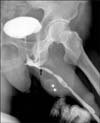Abstract
We experienced the growth of urethral hair along the urethral stricture six years after simultaneous urethral repair and reimplantation of penile prosthesis (RPP) in a patient with a urethral stricture. We detected hair in the urethra with a stricture on the bulbous urethra. Further, we performed hair removal by using a pair of cystoscopic forceps and internal urethrotomy. Then, we performed RPP, and the patient voided well; the prosthesis worked very well and without any complications. One-stage urethroplasty with a pedicle island of the penile skin and RPP in a simultaneous stage may be an option for treating the long-segment urethral stricture in the penile prosthesis patient. However, we should pay attention to the urethral hair growth that can occur after urethral repair performed using a skin graft.
Previously, we reported the unusual success of one-stage urethroplasty with a pedicle island of penile skin (PIPS) and reimplantation of penile prosthesis (RPP) that was performed in one stage in a patient with a severe urethral stricture secondary to the compression of the twisted tubing [1]. However, in the same patient, we experienced the growth of urethral hair along the urethral stricture six years after previous surgery.
We would like to report our experience, demonstrating that urethral hair growth can occur after urethral repair performed using a penile skin graft for a urethral stricture induced by RPP.
A 41-year-old male presented with a long history of voiding difficulty and malfunction of a penile prosthesis (PP) from seven months ago.
Ten years ago, he underwent implantation using a PP via an infrapubic approach. The patient was satisfied with the PP. About 4 years after the implantation, he complained of voiding difficulty aggravation. Retrograde urethrogram (RGU) showed that the length of the penile urethral stricture was about 4 cm. Further, the twisted tubes were palpated over the penile urethra by a physical examination. We performed one-stage urethroplasty and RPP. After excision of the stricture segment, the revealed stricture defect was approximately 4 cm in length. We made a neo-urethra with PIPS. After urethroplasty, in a routine manner, new cylinders were placed in the cavernosal spaces and new pumps were placed in the intrascrotal space. The PP and neo-urethra were functioning satisfactorily at the 1-year follow-up without any voiding difficulty. Two years after urethroplasty, the patient visited the hospital and complained of a mild voiding difficulty. Pyuria (white blood cell: 25~30/high-power field) was detected. On uroflowmetry, the maximum flow rate was 10 ml/s, the voided volume was 210 mL, and the residual volume was 120 mL. RGU showed a bulbous urethra (Fig. 1). Therefore, the patient had to undergo intermittent urethral dilation with sounds (16~20-French [Fr.]).
The patient underwent cystoscopy while under general anesthesia. We detected hair in the penile urethra and a stricture on the bulbous urethra (Fig. 2). Hairs were removed by a pair of cystoscopic forceps, and internal urethrotomy was performed (Fig. 3). A 16-Fr. Foley catheter was inserted into the urethra. Then, the old PP was successfully removed. Thereafter, we performed RPP with Titan® (Coloplast Corp., Minneapolis, MN, USA).
The patient was discharged on day one postoperatively with a Foley catheter and a 10-day course of medications consisting of third-generation cephalosporin, metronidazole, rifampin, and levofloxacin for the prevention of inflammation at RPP. Ten days later, the Foley catheter was removed. One month later, we observed that the patient's voiding symptoms and the parameters (maximum flow rate: 13 mL/s, voided volume: 220 mL, and residual volume: 10 mL) had improved, and the PP was functioning satisfactorily.
The formation of a urethral stricture after the implantation of a PP is rare by a compression of twisted tubes, which occurs in a patient with a PP [2]. Unfortunately, the urethral stricture has been severely aggravated, and complicated operations are needed as time passes. One-stage urethroplasty with PIPS and RPP is a good surgical option for a urethral stricture caused by PP implantation [1].
One of the recognized complications of urethroplasty with PIPS is hair that develops within the urethra [3]. This complication ultimately causes urinary tract infections and stone disease, particularly where there is a pooling of urine within the neourethra. Fistula formation and abscess development occur. Further, the most widely recommended treatment is an excision of the hair-bearing urethral portion and reconstruction with the non-hair-bearing skin. Numerous treatments have been used, including transurethral laser ablation and urethral instillation of depilatory cream [4].
To the best of our knowledge, we report the first case of urethral hair growing after simultaneous urethral repair using PIPS and RPP. Hair bezoars resulting from the use of penile skin for a urethral stricture in PP patients are a difficult problem to manage. We successfully performed the first case of hair removal by using a pair of cystoscopic forceps and internal urethrotomy with RPP.
One-stage urethroplasty with PIPS and RPP simultaneously may be a choice to treat the long-segment urethral stricture caused by PP implantation. However, the clinician should take care to note any urethral hair growth, which can occur after urethral repair by using a skin graft. Further, in the future, we should perform reconstruction with non-hair-bearing skin.
Figures and Tables
References
1. Cui WS, Kim SD, Choi KS, Zhao C, Park JK. An unusual success with simultaneous urethral repair and reimplantation of penile prosthesis in a patient with urethral stricture induced by rotated tubing. J Sex Med. 2009; 6:1783–1786.

2. Lee SW, Park BH, Lim JH, Cui WS, Kim MK, Park JK. Prevention of urethral stricture in insertion of an inflatable penile prosthesis. Int J Urol. 2008; 15:162–165.

3. Kukreja RA, Desai RM, Sabnis RB, Patel SH, Desai MR. The urethral instillation of depilatory cream for hair removal after scrotal flap urethroplasty. BJU Int. 2001; 87:708–709.

4. Finkelstein LH, Blatstein LM. Epilation of hair-bearing urethral grafts utilizing the neodymium:YAG surgical laser. Lasers Surg Med. 1990; 10:189–193.




 PDF
PDF ePub
ePub Citation
Citation Print
Print





 XML Download
XML Download